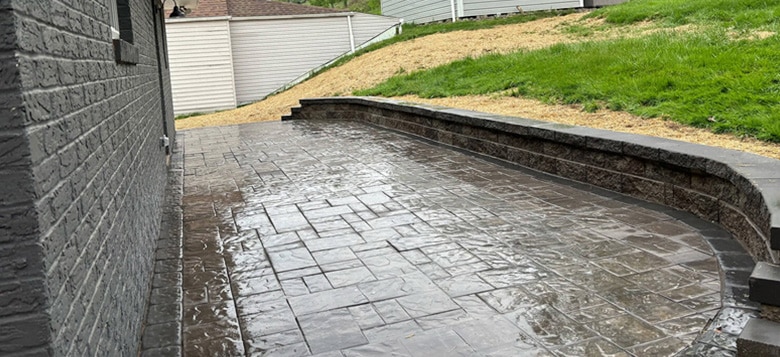Stone steps and stone walkways can significantly enhance the look and functionality of your yard. They are durable, weather-resistant, and add a timeless appeal to any landscape. This article covers top ideas for integrating stone into your outdoor space, how to choose the right materials, and tips for installation and maintenance, helping you efficiently complete your entire project from start to finish.
Key Takeaways
- Natural stone steps enhance functionality and aesthetics in outdoor spaces, offering durability and a picturesque landscape.
- Selecting the appropriate stone for walkways is crucial, considering factors such as climate, durability, and budget to ensure longevity and aesthetic harmony.
- Paying close attention to detail during the planning and installation of stone steps and walkways ensures optimal results and elevates the overall design.
- Regular maintenance, incorporating plants, and utilizing landscaping fabric contribute significantly to the stability and appeal of stone walkways.
Transform Your Yard with Stone Steps
Natural stone steps have a remarkable ability to transform any yard into a picturesque landscape. These stones are known for their durability and can withstand even the harshest weather conditions, ensuring safety and longevity. Integrating stone steps improves access to different parts of your house, such as the front door and backyard, enhancing both functionality and visual appeal.
Stepping stones in your gardens define paths, prevent soil compaction from foot traffic, and add visual interest. For instance, a gravel and stepping stone walkway provides a natural look that complements any garden style, enhancing gardens by allowing for proper drainage and reducing erosion risk. The versatility of natural stone allows for creative designs in various shapes and sizes, making it possible to personalize your garden pathways uniquely.
Moreover, upgrading old concrete stairs with natural stone steps can significantly enhance both the function and appearance of your outdoor space. Using thick stones for steps increases durability and stability, making them ideal for outdoor surfaces. Imagine walking through your garden, each step revealing a new perspective of your landscape design, harmoniously blending with nature. It’s an investment that not only beautifies your yard but also adds to the overall value of your home.
Preparing the Site for Stone Walkways and Steps
Before you begin installing a stone walkway or stone steps, preparing the site is essential for creating a beautiful and long-lasting outdoor space. Start by carefully assessing your yard’s topography—look for slopes, uneven ground, or low spots that could affect the stability of your walkway or steps. Understanding the lay of the land helps you plan for proper drainage, which is crucial for preventing water from pooling around your stones during heavy rains or various weather conditions.
Next, evaluate the soil type in your landscape. Well-draining soil is ideal, as it helps maintain a stable base and reduces the risk of cracks or shifting stones over time. If your soil retains too much water, consider amending it or installing additional drainage solutions to ensure your stone features remain stable and secure.
Creating a stable base is the foundation of any successful stone walkway or steps. This process typically involves digging out the area, laying down a layer of compacted gravel, and topping it with sand before placing your stones. Taking the time to prepare the site properly not only ensures the stability and longevity of your walkway but also helps the finished project blend seamlessly with the natural surroundings. By focusing on these essential steps, you’ll have a stone walkway or steps that withstand various weather conditions and enhance the natural look of your entire outdoor space.

Choosing the Right Stone for Your Walkways
Selecting the right stone material for your walkways is crucial for ensuring durability and aesthetic harmony. Choosing the appropriate material can greatly impact both the longevity and visual appeal of your walkway. Granite, known for its exceptional durability and low maintenance, is an excellent choice for high-traffic areas. On the other hand, limestone, while offering a softer appearance, can stain and erode over time, making it less suitable for areas exposed to harsh weather.
The climate in Pittsburgh, with its cold winters and hot summers, also plays a significant role in stone selection, especially under various weather conditions. Bluestone and granite are ideal for colder climates, while travertine and sandstone perform better in warmer environments. Flagstone, a durable, flat stone material, is also a popular choice for walkways and garden paths due to its versatility and local availability. Rock is an important consideration in this context.
Budget considerations are equally important. High-end stones like granite provide longevity and low maintenance but come at a higher cost. It’s essential to balance your budget with the desired durability and style, ensuring the stones you choose align with the overall design and landscaping of your property. A well-chosen stone not only enhances the walkway’s appearance but also integrates seamlessly with the existing landscape design. Additionally, certain stones or gravel are comfortable under feet, making the walking experience more enjoyable.
Designing Natural Stone Walkways
Designing natural stone walkways involves more than just laying stones; it’s about creating pathways that connect various areas in your yard, enhancing both function and aesthetics. Consider the following when designing your walkway:
- The scale of your walkway is crucial; overly wide paths can dominate the space, while too narrow paths may be difficult to navigate.
- For a formal feel, straight paths are ideal.
- Meandering paths are better suited for informal landscapes.
- Integrating different materials can create visual transitions that distinguish various outdoor areas, adding to the overall appeal.
Visualizing your design can be made easier with tools like a garden hose or mason line, which help outline the path and make adjustments before you install. Measuring the desired path length and spacing between stones is essential for proper installation, ensuring each project step has the right slope and is comfortable and visually appealing.
The design process also allows for creativity and personalization. By combining stones of varied sizes and shapes, you can achieve a natural appearance and create unique patterns that reflect your style and the natural look you wish to achieve. Before installation, arrange the stones on one side of the path to help with selection and placement, making it easier to visualize the final layout. This thoughtful approach to design not only enhances the beauty of your space but also makes it more inviting and functional, showcasing your ideas.
Creating a Focal Point with Stone Features
Stone features are a fantastic way to create a focal point in your outdoor space, drawing attention and adding a sense of purpose to your landscape design. Whether you choose stepping stones, a straight path, or a set of stone steps, these elements can transform an ordinary yard into a visually captivating garden.
To make your stone features stand out, consider using natural stone like granite or limestone. These materials not only offer durability but also bring a timeless elegance to your garden. The shape and size of your stones can be tailored to suit your desired effect—a straight path made of uniform stones can create a formal, structured look, while a winding path with irregular shapes adds a touch of whimsy and invites exploration.
For example, a series of granite stepping stones leading to a cozy seating area can serve as a visual anchor, guiding visitors through your garden. Alternatively, a set of limestone steps can highlight a change in elevation, making the transition between different areas of your yard both functional and beautiful. By thoughtfully incorporating stone features into your landscape, you create a space that is not only practical but also rich in visual interest and natural charm.
Maintenance Tips for Long-Lasting Walkways
Regular maintenance is essential for the longevity of your stone walkways. Key maintenance steps include:
- Inspect pathways after each season to identify and address cracks and shifting surfaces.
- Before winter arrives, check for any damage and repair it promptly to prevent further deterioration.
- Regularly clean the walkways to prevent damage from dirt and moisture, which can deteriorate the walkways over time.
- Filling gaps between stones with gravel or sand is important to maintain a smooth and stable walkway surface.
Weed control is another crucial aspect of walkway maintenance. Weeds can disrupt pavers and attract pests, so keeping them at bay is essential. Using landscape fabric can significantly reduce the time and effort required for weeding, making it a major advantage for gardeners. Additionally, applying appropriate sealants can help fill minor cracks before they worsen, preserving the integrity of your walkways.
Incorporating Plants into Stone Pathways
Incorporating plants into stone pathways can enhance their aesthetic appeal and create a welcoming atmosphere. Integrating stone pathways with a well-maintained lawn not only boosts visual appeal but also helps protect garden features, making the landscape more cohesive. Using moss or ground cover plants between stones can add visual softness and a lush, cohesive look. Flowers and greenery around stone pathways further enhance the aesthetic, making your garden inviting for visitors.
Choosing plants that thrive in the specific sunlight conditions of the pathway is essential for maintaining their health and appearance. Succulents and low-growing plants are excellent choices for planting alongside stones due to their low maintenance requirements.
By carefully selecting and placing plants, you can create a harmonious blend of stone, lawn, and greenery that elevates the beauty of your garden pathways and blends seamlessly along a straight path. For example, this approach can enhance any outdoor space.
Adding Decorative Elements to Your Stone Walkways
Enhancing your stone walkway with decorative elements is a great way to boost its aesthetic appeal and make your outdoor space truly unique. One effective technique is to use polymeric sand to fill the gaps between stones. This not only creates a smooth, stable surface but also helps prevent weeds from sprouting, keeping your walkway looking neat and well-maintained.
Incorporating plants or grass between the stones can add a lush, natural touch to your walkway. Low-growing ground covers or tufts of grass soften the edges and create a seamless transition between the walkway and the surrounding garden. Edging materials, such as metal or plastic, can be used to define the borders of your walkway, giving it a crisp, finished look and helping to keep gravel or soil in place.
For added visual interest, consider installing outdoor lighting along the path or placing decorative garden ornaments nearby. These elements not only enhance the beauty of your walkway but also improve safety and usability after dark. By thoughtfully adding these decorative touches, you can create a stone walkway that is both functional and visually stunning, perfectly complementing your landscape.
Safety Considerations for Stone Steps and Walkways
When designing and installing stone steps and walkways, safety should always be a top priority to ensure your outdoor space is enjoyable for everyone. One of the main concerns is that stone surfaces can become slippery, especially when wet. To reduce the risk of slips and falls, opt for stones with a natural, textured surface or apply a non-slip coating to enhance traction.
Proper drainage is another key factor in maintaining a safe walkway. Make sure your stone steps and walkways are designed to channel water away, preventing puddles and slippery surfaces during rain or after watering your garden. Additionally, pay close attention to the dimensions of your steps and walkways—ensure that steps are of a comfortable height and depth, and that walkways are wide enough for easy passage.
Regular maintenance is essential for safety and longevity. Keep your stone surfaces clean and free of debris, and inspect them periodically for any signs of damage or unevenness. Promptly addressing any issues will help prevent accidents and keep your outdoor space looking its best. By considering these safety tips, you can create stone steps and walkways that are not only beautiful but also secure and accessible for all.
The Benefits of Landscape Fabric
Landscape fabric is a valuable tool in maintaining the stability and appearance of stone walkways. Its benefits include:
- Preventing weeds from growing between stones, reducing the need for constant weeding.
- Keeping gravel in place, ensuring a clean and well-defined path.
- Acting as an insect barrier, minimizing the chances of pests settling in the gaps of paving stones.
Using landscape fabric contributes to the overall aesthetic appeal of your walkway by maintaining a neat and tidy appearance. It also extends the life of your walkway by preventing soil erosion and enhancing drainage, making it an essential component of any well-designed landscape.
Weather-Proofing Your Stone Walkways
Weather-proofing your stone walkways is essential for their longevity and performance. Key steps include:
- Investing in high-quality stone materials to enhance durability against severe weather conditions.
- Cleaning and sealing stone walkways to protect against moisture and freeze-thaw cycles that could cause damage.
- Using non-corrosive de-icing materials to prevent harm to the stone during ice removal in winter.
Seasonal changes can affect the performance of materials used in pathways, especially in colder climates like Pittsburgh. Certain types of landscape fabric can improve drainage, helping to avoid water pooling in garden areas during the fall, particularly during heavy rains. Taking these weather-proofing measures ensures your stone walkways remain secure and visually appealing year-round.

Summary
In summary, stone steps and walkways are a beautiful and practical addition to any outdoor space. By choosing the right materials, designing thoughtfully, and maintaining diligently, you can create pathways that enhance the aesthetics and functionality of your garden. To further elevate both the look and utility of your landscape, consider adding a fence to define spaces, increase privacy, and complement your stone features. At Cascades Landscaping, we are committed to helping you achieve your landscaping dreams, turning your yard into a picturesque haven. Start your journey today and transform your outdoor spaces with the timeless beauty of natural stone. Call us at 412-609-2732.
Frequently Asked Questions
What types of stones are best for walkways in cold climates?
Bluestone and granite are the best stones for walkways in cold climates because of their durability and resistance to freeze-thaw cycles. These materials will ensure longevity and stability in harsh weather conditions.
How can I prevent weeds from growing between the stones in my walkway?
To prevent weeds from growing between the stones in your walkway, utilize landscape fabric beneath the stones and fill the gaps with polymeric sand. This method effectively inhibits weed growth, ensuring a cleaner and more aesthetically pleasing walkway.
What is the best way to maintain my stone walkway during winter?
To effectively maintain your stone walkway during winter, regularly inspect for cracks, clean and seal the stones, and utilize non-corrosive de-icing materials to prevent damage. This proactive approach will help ensure the longevity of your walkway.
How can I incorporate plants into my stone pathway without damaging the stones?
Incorporating low-maintenance plants such as succulents and ground covers into your stone pathway can be done without damaging the stones by ensuring they are suitable for the sunlight conditions of the area. This approach not only enhances the aesthetics but also maintains the integrity of the pathway.
What materials are recommended for creating a stable base for stone walkways?
For a stable base for stone walkways, it is recommended to use geotextile fabric, crushed stone, and leveling sand, all properly compacted to ensure durability and prevent shifting. This combination will effectively manage water damage and maintain the integrity of the walkway.

